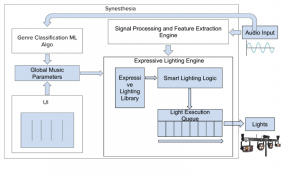Summary
Overall, we made significant headway in getting the project started. We consolidated the design for the subsystems and figured out the communication between them, which is critical for our project. We spent some time setting up the hardware in the Media Lab and understanding how to best utilize it. We also established the requirements for each subsystem we will be utilizing for development going forward.
Risks
Currently, we are using QLC+ to drive communication with the lights. QLC+ is developed on C++ making it fast, but there are still latency issues if we are using the API within our python program. We will be attempting to completely remove our dependence on QLC+ by trying to communicate directly with the I/O, which might be a risk for the project. This risk is not critical, however, as we know that we can always fall back upon QLC+, which albeit slower, is still reliable.
Changes
We changed the functionality of the lighting engine subsystem, effectively splitting it into two. Now the lighting engine is going to consist of python objects and their behaviors. This system will then be called by the direction layer, which will take in the inputs from the user and the audio to determine what parameters to pass into the objects to accomplish the desired light behavior.
The subsystem change was necessary to increase the modularity of the subsystem and to divide labor better. However, given this is simply a software update, there aren’t any changes to the overall cost.
Updated Schedule
Overall, there are little changes to the schedule, but we decided that we are going to take a top-down development approach. We will start development simultaneously with the lighting engine, UI, and genre classifiers so that we have quantifiable deliverables for each week going forward. This will also allow us to integrate subsystems much earlier, allowing more flexibility and leaving adequate time for testing.

Our project includes considerations for public health and safety, such as ensuring that the lighting system does not pose a risk to performers or audience members, as well as global environmental sustainability by minimizing the energy consumption of the lighting system. We also consider cultural and societal factors, such as ensuring that the lighting system is inclusive and respectful of diverse audiences and performers. Additionally, we consider economic factors by developing a system that is affordable and accessible to a wide range of users.